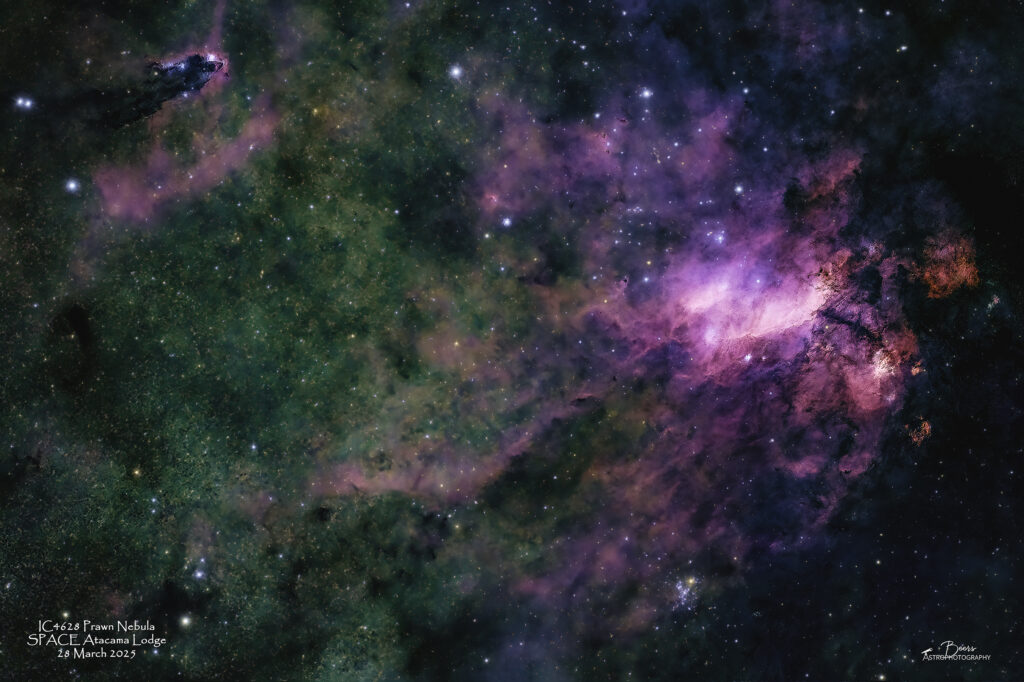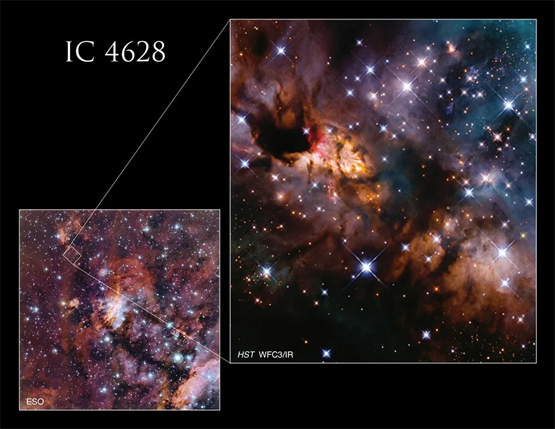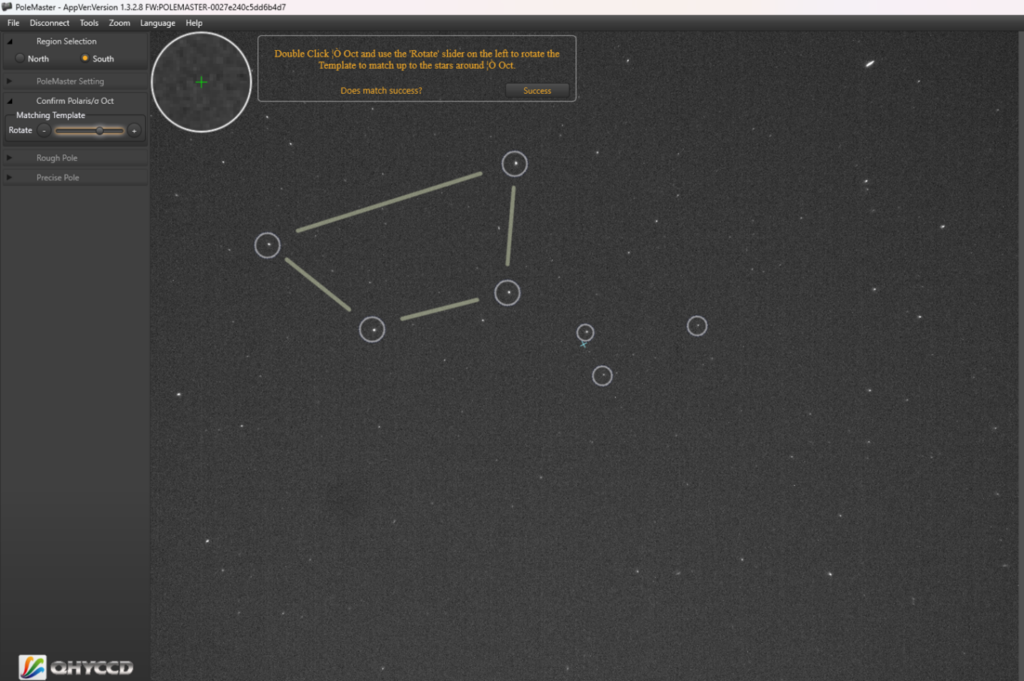
Fun facts
Prawn Nebula, also known as IC 4628, is located in the Sagittarius Arm of the Milky Way, around 6,000 light-years from Earth in the constellation Scorpius. It forms part of the tail of the “False Comet” anchored by the bright open cluster NGC 6231.
{From: https://en.wikipedia.org/wiki/Prawn_Nebula}
The Prawn Nebula, is a massive stellar nursery and an emission nebula, meaning its made up of gas that has been energized, or ionized, by the radiation of nearby stars. The radiation from these massive stars strips electrons from the nebula’s hydrogen atoms. As the energized electrons revert from their higher-energy state to a lower-energy state by recombining with hydrogen nuclei, they emit energy in the form of light, causing the nebula’s gas to glow. In this image, red indicates the presence of ionized iron (Fe II) emission. Though the nebula stretches 250 light-years and covers a space four times the size of the full moon, it emits light primarily in wavelengths the human eye cannot detect, making it extremely faint to earthbound viewers. Hubble’s gaze, however, shows a small section of the nebula below shown in both visible and invisible infrared light, capturing dazzling detail of the nebula’s structure, including bright areas of glowing gas.
This Hubble Space Telescope image was captured as part of a survey of massive- and intermediate-size “protostars,” or newly forming stars. Astronomers used the infrared sensitivity of Hubble’s Wide Field Camera 3 to look for hydrogen ionized by ultraviolet light ionized by the protostars, jets from the stars, and other features. {From: https://science.nasa.gov/missions/hubble/hubble-catches-celestial-prawn-drifting-through-the-cosmic-deep/}

Distance: 6000 light years
Apparent dimensions: 90′
Constellation: Scorpius
Other Designations: HD 152723, CSI-40 10986 21, Hbg 1258, SAO 227479, ALS 3854, CSV 102812, HIC 82936, SKY# 30546, CD-40 10986, GC 22819, HIP 82936, TD1 19710, CEL 4464, GCRV 9755, IC 4628, UBV 14329, CGO 429, GEN# +1.00152723J, LS 3854, uvby98 100152723 ABC, Cl Trumpler 24 405, GOS G344.81+01.61 01, MCW 1270, CPC 0 15594, GSC 07872-02169, NSV 8060, CPD-40 7650, GUM 56, PPM 322447
{From: https://en.wikipedia.org/wiki/Prawn_Nebula}
Capture & Processing Notes
This was the night from hell for polar alignment! Even though we had successfully polar aligned the mount the night before (after about 2 hours of fiddling around with Alain’s website’s figure as a guide), I couldn’t leave well enough alone. Once we could not immediately find the σ Oct template stars in the Polemaster field of view, I foolishly started moving things around (as I’d done on the second night last year with the same deleterious effect!!). Dave and I spent from 20:15CDT, when I cockily went into their lodge and announced “want to come watch how quickly this will go, compared to last night?” until 01:00, when we left for the star tour that Alain was putting on for the lodge guests after all his paying tours ended. I walked over to the star tour a little early, hoping to catch Alain before it started to beg him to help me with the polar alignment. No joy, Alain was still inside with his last tour (a special group that had paid for the hour outside of through the telescope viewing and then another hour inside Alain and Ale’s house chatting. As I was standing there lamenting how long we’d been working on the polar alignment with no success to our Canadian Astronomical League member neighbors, one of them (Daryl) said “I can come over and take a look.” I immediately took him up on his offer and we walked over to my lodge and the mis-aligned telescope. I showed him the rig and the Polemaster software’s screen and template (i.e., what we were looking for on the screen). He verified that we seemed to be pointing in the right direction, although lowering the inclination angle slightly. He was saying “I don’t know what I can do to help” and about to walk away, when he glanced down at the screen and said casually, “Oh, there it is.” I still couldn’t see it, so I asked him to point to the trapezium, and more specifically σ Oct. He did, I selected it and rotated the template around capturing the seven stars (the trapezium and a triangle of stars above it) that prove that you really have found the correct σ Oct! I stood up and gave Daryl a big hug – I think that surprised and shocked him a bit – but I was so relieved that I couldn’t help myself!! By this time it was 01:20 – so we’d been at the task of finding that peskily dim σ Oct for over five hours! Daryl went back to the star tour and I got the sequence started to capture IC4628 Prawn Nebula. (My initial plan for the night was to capture the Dolphin Nebula and switch to the Prawn when it set, but by the time the mount was finally polar aligned the Dolphin had long since set for the night.)
I finished the polar alignment, connected the equipment and started on the IC4628 Prawn Nebula SGP sequence. The sequence aborted when it got to the autoguider calibration because the camera wouldn’t connect. (Of course it did, why would anything go right at this point??) I recycled power and disconnected/reconnected the autoguide camera cable and restarted the process. I finally got the sequence started at 02:05CDT – a mere six hours from the start!
The sequence went well after that point. It was to have a meridian flip at 06:00CDT, so I decided with astronomical twilight ending at 06:51 I wasn’t going to bother with the meridian flip. I just let the sequence run until about 06:20CDT, then got up to shut it down for the night. Once that was done and the calibration frames were captured, it was still dark. Earlier in the morning, I hadn’t captured a screen shot in my zeal to get the process going after we finally found the σ Oct template stars (I tried print screen but it wasn’t working. I looked up later, the shortcut for the snipping tool is: Windows-Shift-S). So, I decided I would retry finding the σ Oct template stars and capture a screen shot using the snipping tool. I set up the Polemaster and did just that. Below is the “map” I created to help me in the future…and as input for a blog on the subject, to be developed.

Sequence Plan (29Mar2025): Gain 158, Offset 30, Temp 0°C; 47x5min. Captured 29Mar2025, 02:05CDT – 06:24CDT. Total exposure time: 3:55hrs.
Processing summary: Captured in SGP, stacked in APP (Adaptive Airy), star removal with Starnet++, processing with LR/PS
Equipment
Equipment: All equipment controlled by HP Probook (DSO CTRL1) running Sequence Generator Pro v4.4.0.1441.
- Imaging (ASI2400-SC): ZWO ASI2400MC imaging camera; (Southern Cross) Askar FRA600 108mm f/5.6 Quintuplet Petzval Flat-Field Astrograph
- Autofocuser: ZWO EAF Electronic Automatic Focuser – Standard (EAF-5V-STD)
- Mount: Rainbow Astro RST-135E (controlled by iHubo ASCOM driver)
- Polar alignment: QHYCCD camera (controlled by Polemaster for polar alignment)
- Autoguiding: Orion 60mm Multi-Use Guide Scope with Orion StarShoot AutoGuider Pro Mono Astrophotography Camera (controlled by PHD2)
Summary
Captured: 29Mar2025, 02:05CDT – 06:24CDT. Total exposure time: 3:55hrs.
Shooting location: San Pedro de Atacama Celestial Explorations (SPACE) Atacama Lodge, Chile
Equipment: Southern Cross on Rainbow Astro RST-135E
Processing summary: Captured in SGP, stacked in APP (Adaptive Airy), star removal with Starnet++, processing with LR/PS
